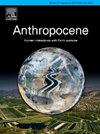A comprehensive method for source identification and environmental capacity of agricultural soil heavy metals: A case study in Yiwu City, China
IF 3.3
2区 地球科学
Q2 ENVIRONMENTAL SCIENCES
引用次数: 0
Abstract
Accurate identification of heavy metals (HMs) pollution sources is a premise for effective management of HMs pollution, while the existing source apportionment methods are subject to greater human subjectivity. Taking agricultural soil in Yiwu City as a case study, based on receptor models, GeoDetector was introduced to compensate for the defects that receptor models could not consider the spatial geographic information, to reduce the interference of anthropogenic subjective judgments on the identification of HMs pollution sources. In this study, the GeoDetector involves natural explanatory variables (slope, aspect, and elevation) and anthropogenic explanatory variables (land use type, pH, and the nearest distance from the sampling site to rivers, factories, roads, railways and residential areas). With the assistance of GeoDetector, the source apportionment results showed that HMs originated from fertilization (43.38 %), emissions from traffic and urban household (32.64 %), and river irrigation (23.98 %). Whether concentration-oriented or source-oriented, probability of health risk for population is very low. Soil HMs had a mild comprehensive environmental capacity (EC) risk (PI = 0.93), and Cd brought by fertilization reached a moderate EC risk (Pi = 0.41). This study can provide reference for the priority control of soil HMs pollution sources, in order to effectively reduce pollution risks.
农业土壤重金属来源识别与环境容量综合方法研究——以义乌市为例
准确识别重金属污染源是有效管理重金属污染的前提,而现有的污染源分摊方法受人的主观性较大。以义乌市农业土壤为例,在受体模型的基础上引入GeoDetector,弥补受体模型不能考虑空间地理信息的缺陷,减少人为主观判断对土壤有机质污染源识别的干扰。在本研究中,GeoDetector涉及自然解释变量(坡度、坡向和海拔)和人为解释变量(土地利用类型、pH值以及采样点到河流、工厂、公路、铁路和居民区的最近距离)。在GeoDetector的辅助下,污染源分配结果表明:施肥(43.38 %)、交通和城市家庭排放(32.64 %)和河流灌溉(23.98 %)是主要污染源。无论是集中型还是源型,人口健康风险的概率都很低。土壤HMs具有轻度综合环境容量风险(PI = 0.93),施肥带来的Cd具有中度综合环境容量风险(PI = 0.41)。本研究可为土壤有机质污染源的优先控制提供参考,以有效降低污染风险。
本文章由计算机程序翻译,如有差异,请以英文原文为准。
求助全文
约1分钟内获得全文
求助全文
来源期刊

Anthropocene
Earth and Planetary Sciences-Earth and Planetary Sciences (miscellaneous)
CiteScore
6.30
自引率
0.00%
发文量
27
审稿时长
102 days
期刊介绍:
Anthropocene is an interdisciplinary journal that publishes peer-reviewed works addressing the nature, scale, and extent of interactions that people have with Earth processes and systems. The scope of the journal includes the significance of human activities in altering Earth’s landscapes, oceans, the atmosphere, cryosphere, and ecosystems over a range of time and space scales - from global phenomena over geologic eras to single isolated events - including the linkages, couplings, and feedbacks among physical, chemical, and biological components of Earth systems. The journal also addresses how such alterations can have profound effects on, and implications for, human society. As the scale and pace of human interactions with Earth systems have intensified in recent decades, understanding human-induced alterations in the past and present is critical to our ability to anticipate, mitigate, and adapt to changes in the future. The journal aims to provide a venue to focus research findings, discussions, and debates toward advancing predictive understanding of human interactions with Earth systems - one of the grand challenges of our time.
 求助内容:
求助内容: 应助结果提醒方式:
应助结果提醒方式:


